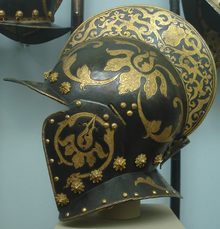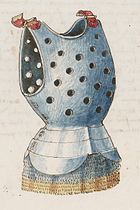Burgonet
Appearance

The Burgonet helmet (sometimes called as bourgundian sallet) was a late mediæval/early modern combat helmet. It was the successor of the sallet.
It came into popularity towards the end of the 16th century. Commonplace throughout Europe the Burgonet was accompanied by plate armour and worn by cuirassiers. It was a light helmet, open-faced and decorated with one or more metal fins on top. Though typically open faced, a falling buffe, a sort of visor that was drawn up rather than down, could be used.
The factors of utility of the Burgonet over older helmets include:
- Cost — The main factor in the decision to wear one; Burgonets were significantly cheaper than large closed-face helmets
- Encumbrance — Closed helmets were very bulky and heavy. It could be hard to see, breathe or turn your head while wearing one. The Burgonet however was light and had an open face; this gives an advantage in offense.
- Protection — The Burgonet was not as protective as heavier helms, but still afforded some protection. Having an open face could be remedied with a falling buffe.
External links
Wikimedia Commons has media related to Burgonet.
- Spotlight: The Burgonet (myArmoury.com article)

